Biosphere
![]()
This article deals with the space of a celestial body inhabited by living organisms. For other meanings, see Biosphere (disambiguation).
The biosphere [bioˈsfɛːrə] (from Greek βίος bíos 'life' and σφαίρα sphaira 'sphere') refers to the totality of all spaces of a celestial body in which living things occur. Most commonly, the term refers to the Earth's biosphere. The term has undergone two changes of meaning over the past century. At present, it is understood within the life sciences primarily in an ecological sense. Thus, biosphere is used synonymously with the terms biogeosphere, geobiosphere and ecosphere.
Except for the Earth, no other planet, dwarf planet, planetoid or moon has yet been proven to have living beings or at least traces of life. According to current knowledge, a biosphere seems to be a very rare phenomenon, which makes the Earth unique, at least in this solar system.
The biosphere is thought of as a thin shell (sphere) that interweaves an outer region of the Earth. It extends approximately from 5 km below the Earth's surface to 60 km above it, i.e. from the upper lithosphere to the lower fringe of the mesosphere. Its outer regions at depth and height are inhabited exclusively by microorganisms.
Because of its vast extent and complexity, aspects of the biosphere extend into the research fields of many different natural sciences. The biosphere is a real focus of research at least for those natural sciences that move in the transitional field between biology and geosciences - landscape ecology/geoecology and geobiology. In addition, there is biogeochemistry, which deals with the material cycles within the biosphere. And astrobiology tries to find out which conditions lead to the formation of a biosphere and how its presence on other celestial bodies could be detected.
The two scientists Lynn Margulis and James Lovelock developed the Gaia hypothesis in the mid-1960s. It states that the terrestrial biosphere can be regarded as a holistic organism that creates and maintains the conditions that make not only life but also evolution possible. However, this theory is rejected by many scientists, although many of its predictions have already been verified.
Since the emergence of human civilizations, the anthropogenic influence on the Earth's natural spaces has become ever greater. In 1976, the American biologist Raymond Dasmann coined the terms "ecosystem people" and "biosphere people". The former are those ethnic groups living close to nature and influencing only one or a few ecosystems, while the latter are the modern societies that influence a wide variety of habitats worldwide due to global economic interdependencies. Since this influence on the biosphere has become a significant factor since at least the 1800s, as evidenced by the global environmental changes caused by humans, there is discussion of proclaiming the beginning of a new Earth Age - called the Anthropocene. However, a large number of scientists view the current trends for the biosphere with great scepticism and concern.

The biosphere extends up within the Earth's atmosphere to the lower edge of the mesosphere.
Term
The terrestrial biosphere describes the space of the planet Earth in which life occurs. Life is dependent on interacting with its environment. In order to survive, living organisms must exchange substances and energy with their inanimate environment and with each other. They have to form so-called ecosystems. This is a fundamental property of living things. Without ecosystem interactions, life would not be possible. Therefore, life necessarily changes the configuration of the space in which it settles. Since living beings have settled worldwide, the biosphere can be understood as the space of a global ecosystem.
- The terrestrial biosphere describes the space of planet Earth in which life occurs: the space together with the totality of terrestrial organisms and their inanimate environment occurring therein and the interactions of living organisms with each other and with their inanimate environment.
The existence of a global ecosystem was first recognized by the Russian geoscientist Vladimir Ivanovich Vernadsky. To name it, he used a word that had previously been invented by the Austrian geologist Eduard Suess: biosphere.
The biosphere can be divided into three major subunits. The deep biosphere describes the ecosystems of the lithosphere below the earth's surface and soils. The hydrobiosphere describes the parts of the water bodies that are colonized and influenced by living organisms. The third subunit, the geobiosphere, describes the parts of the continents that are inhabited and influenced by living organisms. Because the same word is sometimes used to refer to the entire biosphere, the geobiosphere may be misunderstood.
Biosphere of the microorganisms
The biosphere extends up into the lower edge of the mesosphere. Within the biospheric space, environmental conditions can vary greatly. Therefore, not all areas of the biosphere can be colonized equally well by all living organisms. Multicellular organisms (Metabionta) in particular can only thrive permanently - and of course in the company of many microorganisms - in regions where relatively mild temperatures, pressures, radiation levels, pH values and the like prevail and where there are sufficient supplies of water and nutritional opportunities.
In contrast, the environmental conditions in the biospheric outer zones are becoming increasingly extreme. There, only microorganisms can exist. Under even harsher environmental conditions, even such resistant microbes can only exist in permanent stages. The permanent stages mark the outer limits of the biosphere.
- The terrestrial biosphere describes the space of the planet Earth in which microorganisms occur.
Biosphere of the biomes
Living organisms form biocenoses (communities) with each other. The members of a biocoenosis have a variety of reciprocal relationships, which are summarized as biotic eco-factors. Biocenoses inhabit physiotopes (material places) with each other. A physiotope is a small section of space with a homogeneous appearance that is characterized by a specific, uniform physiosystem (site). The term physiosystem is used to describe the totality of abiotic eco-factors expressed in a physiotope.
The members of the biocenosis interact with each other and with their physiosystem. They form a common structure of action. This structure of action is called an ecosystem.
An ecosystem is a system, an association of interacting units. The system units of the ecosystem consist on the one hand of the living organisms of the biocenosis and on the other hand of the inanimate things of the physiosystem. An ecosystem is an open system: substances and energy enter the ecosystem from the outside, circulate between the system units for a certain time and finally leave it again.
A particular physiosystem allows only a particular biocenosis of those life forms that are adapted to it. However, the biocenosis gradually changes the expression of the abiotic eco-factors of the physiosystem. Through the biocenosis, the physiotope transforms into the ecotope. The ecotope denotes a real place in real space. It is the material counterpart to the ecosystem concept, which is itself thought of in purely functional-abstract terms.
Ecotopes form common ecochores with similar neighbouring ecotopes. Ecochores form common ecoregions with similar neighbour ecochores. Ecoregions form common ecoregions with similar neighbouring ecoregions. WWF distinguishes 825 terrestrial ecoregions worldwide, distributed across 14 main biomes. In addition, there are 426 freshwater ecoregions and 232 marine ecoregions.
Every living organism is part of an ecoregion. This is true even if, at the present time, ecoregions have not yet been designated for all aquatic and, a fortiori, for the purely microbially populated areas of the biosphere. According to the classical definition, the biocenosis of an ecoregion shapes its biome.
- The terrestrial biosphere describes the totality of all biomes of the planet Earth.
| Synonyms of the technical terms used | ||
| Technical term | common synonyms | purely terrestrial synonyms |
| Ecosphere | Biosphere, Biogeosphere / Geobiosphere | - — |
| Ecozone | - — | Zonobiome, main biome, biotype, vegetation zone |
| Ecoregion | Eu-Biom | - — |
| Ecochore | Ecotope structure | - — |
| Ecotope | Biotope | Geoecotope, Tesela |
| Ecosystem | Holocene*, Cen* | Biogeocen* / Biogeocenosis*, Geoecosystem |
| Biocenosis | Biosystem | - — |
| Physiotop | - — | Tile*, Geotope, Landscape Cell*, Plot |
| Physiosystem | Location | Geosystem |
Similar terms
→ Main article: History of the term biosphere
The concept of the biosphere is understood differently by different scientific disciplines. Within the biosciences, the ecological biosphere concept, which was invented by Vladimir Ivanovich Wernadski, has now become widely accepted. However, he did not succeed with the geosciences. To this day, most of them use a biosphere concept that goes back to the French Jesuit Pierre Teilhard de Chardin. Teilhard de Chardin understood the biosphere exclusively as the totality of earthly organisms. Accordingly, he coined a purely biotic concept of the biosphere.
Furthermore, a number of similar terms exist alongside the ecological biosphere term. Some are congruent with it in terms of content. They are called biogeosphere, geobiosphere and ecosphere. While the terms biogeosphere and geobiosphere are comparatively rare, the word ecosphere is frequently used. In fact, ecosphere is considered by some authors to be more appropriate than biosphere to refer to the space of the global ecosystem.
In addition, a further group of terms exists in the environment of the ecological biosphere concept. However, they are not completely congruent with it in terms of content. Instead, they go beyond it by encompassing other parts of the Earth. These are the terms Gaia, System Earth and Bioplanet Earth.
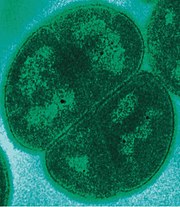
The very radiation-tolerant bacterium Deinococcus radiodurans even survives above the ozone layer.
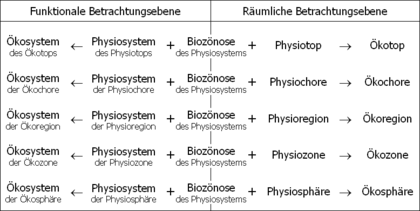
Construction of ecosystems on a functional and spatial level of observation

Hierarchical construction principle of the biosphere (ecosphere). Transitions between neighbouring ecotopes etc. are called ecotones.
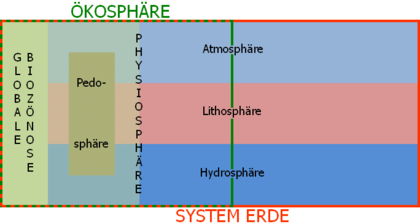
The biosphere (ecosphere) consists of the global biocenosis and its inanimate environment (physiosphere). It belongs entirely to the Earth system. Detailed explanations → image description. Green frame: Biosphere (ecosphere) Orange frame: System Earth
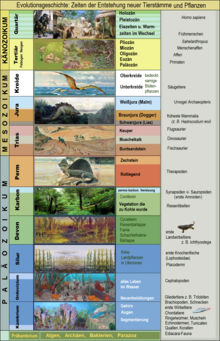
The present (recent) biosphere can be understood as the result of evolutionary history: Display panel focusing on the evolution of animals and plants in the Phanerozoic (Cambrian to present). The Precambrian is indicated at the very bottom as a narrow bar, but it is the longest period of Earth's history. Evolutionary history begins in the early Precambrian with chemical evolution. The taxa are not listed in their phylogenetic order, but in the order of their (first) appearance in the fossil record. During the "Cambrian explosion" many animal phyla arose almost simultaneously.
Extension
The envelope-like biosphere begins about 60 km above the Earth's surface and ends about 5 km below. It begins in the lower fringe of the mesosphere, passes through the remaining underlying layers of the Earth's atmosphere and the upper portions of the hydrosphere, interacts with the pedosphere, and ends in the upper section of the lithosphere, after a few kilometers in the Earth's crust. At least if attention is also paid to microorganisms, the biosphere extends over the entire surface of the earth, the oceans and sea beds.
Vertical extension
According to current knowledge, the upper limit of the terrestrial biosphere is slightly above the stratopause, in the lowest mesosphere at 60 km altitude. There, certain microorganisms still occur in permanent stages. At these atmospheric altitudes they defy the low temperatures, ranging from about -50 °C (lower stratosphere) to about 0 °C (lower mesosphere), as well as the almost complete lack of water and the strong ultraviolet radiation. Currently, the microorganisms found are not thought to go through their entire life cycle so far from the Earth's surface. Instead, they are thought to be merely whirled up from near the Earth's surface along various pathways and then remain in the stratosphere and lowermost mesosphere for some time.
Below the stratosphere is the troposphere, the densest and lowest layer of the Earth's atmosphere. Here, thanks to the natural greenhouse effect, the air has higher air temperatures and is relatively low in radiation due to the stratospheric ozone layer above it. For these reasons, the habitats of terrestrial organisms are located in the troposphere, mostly even just below the nival altitude level due to the temperature.
Below the troposphere are the soils of the pedosphere on the one hand and the waters of the hydrosphere on the other. The soils are inhabited by a variety of soil organisms. Their habitat is limited downwards by the supply of soil water and soil air, with microorganisms penetrating deepest. Intact but frozen microorganisms are found even deep in permafrost. In water bodies, life forms exist all the way to the bottom and many more meters into the muddy bottom. In fact, a greater proportion of Earth's total biomass occurs in the form of archaea and bacteria in ocean sediments. However, the more conspicuous members of aquatic life reside in the upper and light-filled water layers of the epipelagic. Beyond this, species and individual densities can become very low. This is especially true in the deep sea. However, their cold darkness is punctuated by volcanic islands and atolls that rise to above the surface. Undersea, guyots and seamounts provide habitats for many organisms, and some of these undersea mountains may rise up into the epipelagic. Globally, seamounts are very common and collectively occupy an area the size of Europe. Taken together, they probably form one of the larger major biomes. Depending on water depth, volcanic islands, atolls, seamounts, and guyots can host diverse communities, thus interrupting the desert-like nature of the deep sea.
Below the soils and muddy water bottoms join the rocks of the lithosphere. Here, simple cave ecosystems consisting of microorganisms and some multicellular organisms have been found in caves. All other communities in the lithosphere consist entirely of microorganisms. Some live in petroleum reservoirs, coal seams, gas hydrates, in deep aquifers, or in fine pores directly in bedrock. Furthermore, at least certain permanent microbial stages also occur in salt domes. It can be assumed that the biosphere in the lithosphere descends to that depth from which the ambient temperature geothermally rises above 150 °C. Above this temperature it should finally become too hot even for hyperthermophilic microbes. As a rule of thumb, it is assumed that the ambient temperature increases by 3 °C per 100 metres depth. Accordingly, the biosphere should end at a lithosphere depth of about 5 km. However, there are strong regional deviations from this rule of thumb.
Microbial ecosystems can also persist in subglacial lakes that have been completely sealed off from the environment by the overlying glacial ice. Microorganisms are also found deep within the glacier ice itself. It remains unclear to what extent they merely survive there or exhibit active life processes. Researchers from Oregon State University's Deep Carbon Observatory team estimated in 2018 that about 70 percent of the total number of Earth's bacteria and archaea live in the Earth's crust.
Horizontal extension
Living organisms are not evenly distributed throughout the biosphere. On the one hand, there are biomes with large species and individual densities. These include, for example, tropical rainforests and coral reefs. On the other hand, there are also areas with very sparse macroscopic and limited microscopic life. These include, on land, the cold deserts and dry deserts and, in the oceans, the sea beds of the lightless and cold deep sea (bathyal, abyssal, hadal). However, within the desert areas, insular patches of higher biodiversity are interspersed: water oases in the dry deserts, postvolcanic phenomena (thermal springs, solfataras, fumaroles, mofettes) in the cold deserts, and hydrothermal vents (black smokers, white smokers) and methane vents (cold seeps) on the seafloors of the deep sea.
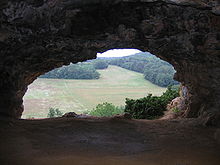
Caves are one way in which the biosphere is extended into the lithosphere.
Search within the encyclopedia